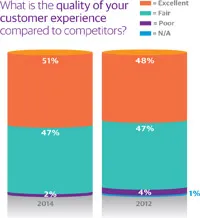Many business leaders often have an inflated notion of the customer experience their companies are delivering. Indeed, numerous research studies have found that the majority of business leaders believe their organizations provide superior customer experiences, while just a fraction of their customers hold the same view.
For instance, the CMO Council’s Customer Affinity study reveals that while half of executives see their organizations as extremely customer centric, only one-tenth of customers for those companies shared the same view. Meanwhile, 53 percent of the 7,500-plus customers who responded to Forrester Research’s 2014 Customer Experience Index in evaluating 175 companies across 14 industries rated their experiences between “OK” and “very poor.”
To that end, many business leaders think their organizations are customer-centric. However, according to successive surveys conducted on customer centricity by Peppers & Rogers Group and Janet LeBlanc + Associates in 2012 and in September 2014, many organizations are achieving mixed progress on the path to customer centricity.
“Executives want to be customer-centric and committed, but being able to put all of the pieces in place in order to execute is the challenge that everyone is faced with,” says Janet LeBlanc, president of Janet LeBlanc + Associates, a consulting firm that helps companies connect customer strategy with business performance.
While many of the 327 survey respondents say their companies have a brand promise that reflects customer centricity, just 20 percent of executives rate their organizations as exceptional in measuring the impact of customer experience initiatives on business performance. Meanwhile, many organizations are underperforming in vital areas such as its use of customer insights to act on and improve customer experiences along with measuring and rewarding employees for customer-centric actions.
The accompanying charts reveal how embedded customer centricity actually is within organizations, and illustrates how elements of customer-centric DNA within businesses have changed from 2012 to 2014.
How customer centricity and customer experience stack up
Although nearly half of the 327 Peppers & Rogers Group/Janet LeBlanc + Associates 2014 survey respondents give high marks to the overall quality of their customer experience their companies deliver, there’s been negligible change since 2012. Clearly, there’s room for improvement among companies that are trailing in this regard.


Although survey respondents view their companies as becoming slightly more customer centric since 2012, the needle hasn’t moved much. “If you want your organization to become customer centric, it’s not just about collecting feedback from customers—that’s just one piece,” says LeBlanc. “Aligning the leadership team with their role in the customer-centric culture is a critical component to success.”
Various research indicates that senior management often has an inflated view of their organization’s customer centricity compared to customer perceptions.
Executive commitment: Walking the walk
For companies that strive to become customer focused, it’s imperative for executive leadership to “walk the walk” and demonstrate customer centricity through their actions and behaviors.
While most companies have a brand promise for customer centricity, many organizations fail to execute on critical aspects of these promises. Less than half of those surveyed consider customer experience a recurring leadership agenda item, and nearly 65 percent don’t consider their companies’ leaders to be customer centric.
“Telling employees that customer centricity is important but then not following through on it is just lip service” says LeBlanc. “When you fail to tie customer experience improvements to executive performance, you are not going to obtain the accelerated improvements needed to drive culture change.”

Developing a ‘sense and respond’ approach
Best-in-class companies regularly collect feedback from customers and use these insights to make improvements to customer-facing processes and as breeding grounds for new product development.

The rise and fall of customer centricity
While companies have made marginal improvements in some aspects of customer centricity since 2012, such as measuring the impact of customer experience initiatives on business performance, other tactics, such as building mutually beneficial relationships with customers, remain flat or have declined.
Developing and nurturing strong relationships with customers and clearly communicating to employees changes they need to make on an individual basis to improve the customer experience are vital “people” components to delivering great customer experiences (the other two legs of the customer experience stool being “processes” and “technology”).
“Employees want to do what’s right for the customer,” says LeBlanc. “Often, employees get caught between what customers want and organizational policies and procedures...The goal should be to translate the ideal customer experience specifically into each employee’s role, tell them what you want them to do differently, and empower them to execute.”
Actionable insight for senior leaders
For both the 2012 and 2014 studies on customer centricity, Peppers & Rogers Group and Janet LeBlanc + Associates categorized the findings into five pillars. While the “strategic alignment” and “senior leadership” pillars improved since 2012, the other categories—“customer insights,” “employee engagement,” and “measures and rewards”—faltered or remained static.
The inroads that companies have made with customer centricity “is a sign of maturity and awareness,” says LeBlanc. “The strategic alignment to customer centricity and the behaviors we expect to see from the senior leadership team are improving year over year and that’s encouraging.”
While companies have made strong gains in some aspects of strategic alignment with customer centricity, including annual reporting customer metrics to investors and key stakeholders, other areas such as the use of performance management to track customer experience improvements, have made little progress.
Another area where many companies continue to underperform is in measuring the impact of customer experience efforts on business performance. Only 30 percent of respondents consider themselves doing a good or excellent job at measurement. Yet failure to do so consistently can have a devastating organizationwide effect.
“If we can’t clearly identify the ROI related to customer experience initiatives, it will never get the attention of the senior leadership team needed to secure the investment dollars that are required,” says LeBlanc.

It’s important for employees to demonstrate customer-centric behaviors throughout all levels of the organization—from the receptionist to customer-facing employees and even back-office employees who interact with customers. “This begins with clearly communicating the role and importance that each employee plays in the customer experience and by highlighting examples of customer-centric behaviors exhibited by individual employees” says LeBlanc.

Companies that effectively gather, analyze, and act on customer insights from across a variety of touchpoints have a much richer understanding of customers and are able to respond quickly to customer issues.



















